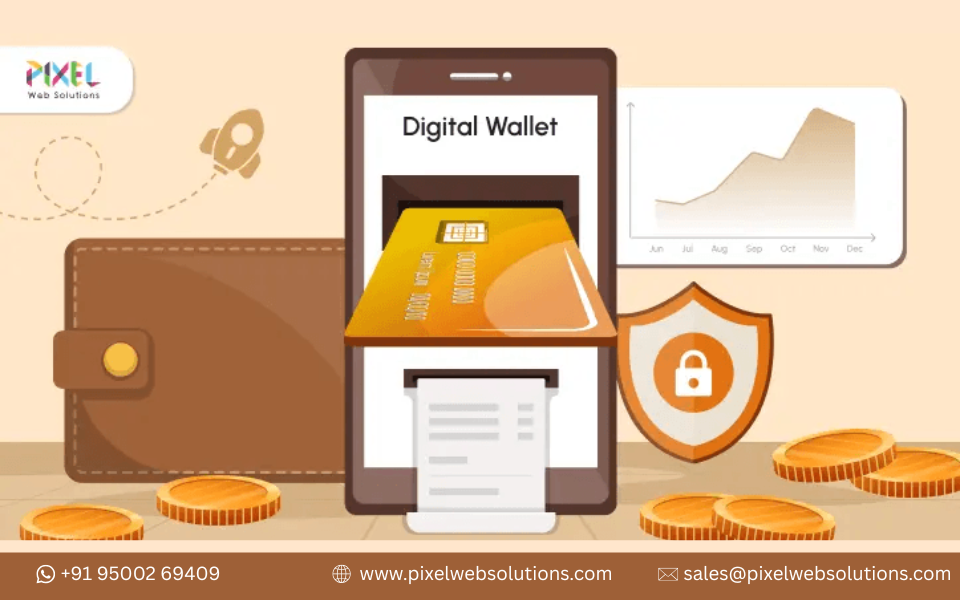The digital payment industry has established itself as the fastest-growing sector in fintech. Users are now demanding that the whole process of managing money through their smartphones is quick, safe, and easy from bill payments and online shopping to P2P transfers. This shift has pushed businesses, small and large, to explore digital wallet app development as a strategic opportunity.
But building a successful wallet app isn’t just about coding a payment interface. It requires deep planning, robust security, and the right mix of features that truly solve user problems. This handbook breaks down everything you need to know before developing a digital wallet app.
What Is a Digital Wallet?
A digital wallet is an application that runs on smartphones or the web with which users can safely keep, move, and handle their money. The various business models allow digital wallets to accept fiat currencies, cryptocurrencies, or even both. Users can associate their bank accounts, store card particulars, perform swift payments, scan QR codes, and receive cashbacks or loyalty points all with just a few clicks.
Digital wallets have become an integral part of financial transactions in everyday life and are not just a means of payment anymore.
Why Businesses Are Investing in Digital Wallet Apps
The digital payments market worldwide is not only growing quickly but also user expectations are changing at the same speed. Developing a digital wallet application has its benefits:
- Convenience and rewards translated into higher customer retention
- Instant payments leading to no transaction friction
- Various sources of income including transaction fees, merchant commissions, and referral programs
- Unique branding in highly competitive sectors such as eCommerce, travel, and fintech
As the number of customers opting for contactless payments increases, the moment has come for businesses to make investment in wallet solutions.
Must-Have Features for a Modern Digital Wallet App
To build a wallet that users trust and enjoy, the app must combine simplicity with powerful functionality. Here are the essential features:
User Features
- Easy onboarding
- Multi-currency support (fiat + crypto)
- Bank account & card linking
- QR/NFC payments
- Transaction history
- Security features (2FA, biometrics)
- Rewards & cashback programs
Admin Features
- User management
- Analytics dashboard
- KYC/AML verification
- Transaction monitoring
- Fraud/risk detection
- Commission settings
These features ensure the wallet is user-friendly, secure, and future-ready.
The Digital Wallet App Development Process
Developing a wallet app requires a structured approach to reduce risk and maintain efficiency. Here's a breakdown of the process:
1. Market Research & Planning
Market research is the first step in building a functional digital wallet. It helps identify your audience, study competitors, and understand user expectations. A strong value proposition ensures your wallet stands out and meets real user needs.
2. UI/UX Design
UI/UX is crucial because users expect a simple, fast, and secure wallet. Clean layouts, smooth navigation, and familiar icons make transactions easier. An intuitive design builds user confidence and encourages regular use.
3. Development (Frontend + Backend)
Development includes creating the wallet’s core system, covering accounts, payment modules, APIs, and admin tools. The frontend manages user interactions, while the backend handles secure processing. Crypto wallets also require blockchain integration and key management.
4. Security Implementation
Handling financial data demands strong security. Key measures include encryption, tokenization, secure APIs, biometric login, and two-factor authentication. Fraud detection and compliance further increase user trust.
5. Testing & Quality Assurance
Before launch, the wallet undergoes performance, security, and usability testing. QA teams fix bugs and ensure device compatibility. Rigorous testing reduces risks and improves reliability.
6. Launch & Post-Launch Support
After deployment, the app becomes available in app stores. Regular updates, bug fixes, and security patches keep it stable and current. Strong post-launch support ensures growth and competitiveness.
Tech Stack for Digital Wallet App Development
The selection of the proper tech stack forms the groundwork of a digital wallet with top-notch performance. The technologies selected influence the speed, security, scalability, and overall user experience of the app. An effective stack guarantees fast transactions, good performance, and long-term flexibility as you expand your user base.
An effective tech stack guarantees both performance and scalability. Popular choices include:
- Frontend: React Native, Flutter, Swift, Kotlin
- Backend: Node.js, Python, Java
- Database: MongoDB, PostgreSQL
- Cloud: AWS, Google Cloud, Azure
- Blockchain (optional): Ethereum, Polygon
Selecting the right stack depends on app complexity, feature requirements, and budget.
How Digital Wallet Apps Make Money
Digital wallet applications are no longer just payment tools they have become highly profitable when supported by a smart monetization strategy. With millions of users relying on mobile payments, businesses now have multiple revenue channels and the opportunity to transform a simple wallet app into a powerful earning platform.
Digital wallets can be profitable through:
- Transaction fees
- Merchant commissions
- In-app advertisements
- Subscription plans
- Referral and affiliate partnerships
A well-designed revenue model can turn your wallet into a long-term business asset.
Conclusion
Digital wallet app development for business is an effective option to bring customers closer to the company, enhance the value of the brand, and gain access to the booming digital payments market. A good combination of features, security, and technology can make a wallet app the main point of interaction between the users and the business.
If you’re planning to build a secure, scalable, and future-ready digital wallet, partnering with an experienced digital wallet app development company can help you prioritize the right features whether that’s top-tier security, reward mechanisms, or multi-currency support and set a solid foundation for long-term success.

